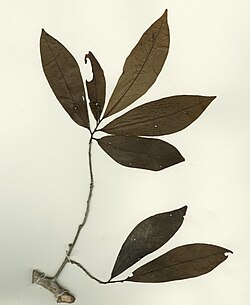Biology:Monodora hastipetala
| Monodora hastipetala | |
|---|---|

| |
| Photograph of an herbarium specimen of Monodora hastipetala.[1] | |
| Scientific classification | |
| Kingdom: | Plantae |
| Clade: | Tracheophytes |
| Clade: | Angiosperms |
| Clade: | Magnoliids |
| Order: | Magnoliales |
| Family: | Annonaceae |
| Genus: | Monodora |
| Species: | M. hastipetala
|
| Binomial name | |
| Monodora hastipetala Couvreur
| |
Monodora hastipetala is a species of plant in the family Annonaceae. It is native to Tanzania.[3] Thomas Couvreur, the botanist who first formally described the species, named it after its spear (hasti- in Latin) shaped inner petals.[4][5]
Description
It is a tree reaching 8 meters in height. Its branches have lenticels. Its papery leaves are 10-12 by 3-4 centimeters and come to a point at their tips. The leaves are smooth on their upper and lower surfaces. Its petioles are 2 millimeters long. Its pendulous flowers are solitary and axillary. Each flower is on a pedicel 17-10 millimeters long. Its flowers have 3 smooth sepals that are 6-7 by 3-4 millimeters with rounded tips. Its 6 petals are arranged in two rows of 3. The white, narrow outer petals are 20-26 by 6-8 millimeters. The outer petals are smooth and wavy. The inner petals are white with purple highlights, have a 4-5 millimeter long claw at their base and a 10-17 by 4-7 millimeter wide blade. The inner petals are densely hairy on the inner surface of their base and less hairy on the outer surface. It has 40-50 stamens that are 0.6 millimeters long. Its bumpy oval-shaped fruit are 30 millimeters long and 20 millimeters in diameter. Its light brown seeds are 10 by 7 millimeters.[5]
Reproductive biology
The pollen of M. hastipetala is shed as permanent tetrads.[6]
Habitat and distribution
It has been observed growing in scrub and coastal forests at elevations from 200 to 400 meters.[7]
References
- ↑ "Monodora hastipetala Couvreur". Tropicos.org. Missouri Botanical Garden. n.d.. https://www.tropicos.org/name/50297215.
- ↑ Cosiaux, A.; Couvreur, T.L.P.; Erkens, R.H.J. (2019). "Monodora hastipetala". IUCN Red List of Threatened Species 2019: e.T157960A133042088. doi:10.2305/IUCN.UK.2019-3.RLTS.T157960A133042088.en. https://www.iucnredlist.org/species/157960/133042088. Retrieved 20 November 2021.
- ↑ "Monodora hastipetala Couvreur". The Trustees of the Royal Botanic Gardens, Kew. n.d.. https://powo.science.kew.org/taxon/urn:lsid:ipni.org:names:77075423-1.
- ↑ Stearn, William (2004). Botanical Latin. Portland, Ore. Newton Abbot: Timber Press David & Charles. ISBN 9780881926279.
- ↑ 5.0 5.1 Couvreur, Thomas L.P.; Gereau, Roy E.; Wieringa, Jan J.; Richardson, James E. (2006). "Description of four new species of Monodora and Isolona (Annonaceae) from Tanzania and an overview of Tanzanian Annonaceae diversity". Adansonia 28 (2): 243–266. http://sciencepress.mnhn.fr/sites/default/files/articles/pdf/a2006n2a2.pdf.
- ↑ Couvreur, Thomas L. P.; Botermans, Marleen; van Heuven, Bertie Joan; van der Ham, Raymond W. J. M. (2008). "Pollen morphology within the Monodora clade, a diverse group of five African Annonaceae genera". Grana 47 (3): 185–210. doi:10.1080/00173130802256913. ISSN 0017-3134.
- ↑ Couvreur, Thomas L. P. (2009). "Monograph of the Syncarpous African Genera Isolona and Monodora (Annonaceae)". Systematic Botany Monographs 87: 1-150. https://www.jstor.org/stable/25592354.
Wikidata ☰ Q17140288 entry
 |


